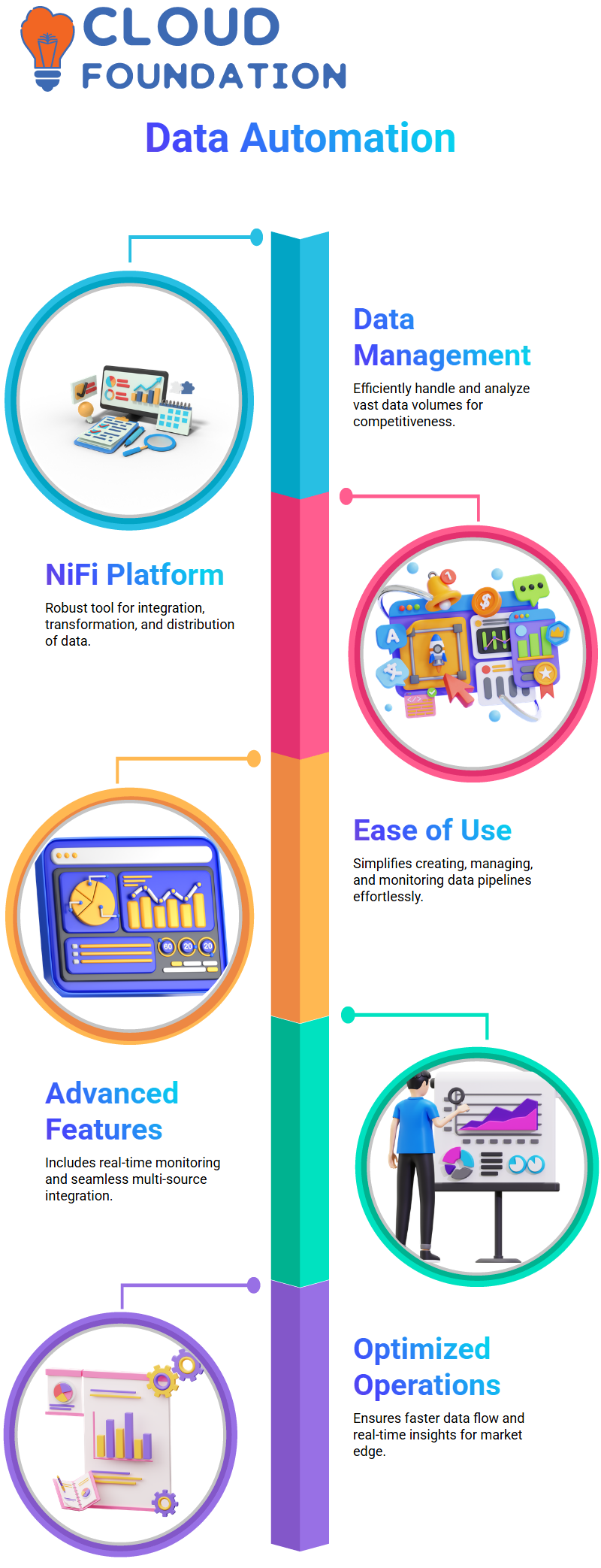Apache NiFi Tutorial
Introduction
To remain competitive in today’s data-driven world, businesses must effectively manage and analyze vast volumes of data.
With its robust and adaptable platform for data integration, transformation, and distribution, Apache NiFi has become a top option for automating data flow.
Apache NiFi is well-known for its scalability and ease of use, enabling companies to create, manage, and monitor data pipelines with minimal effort.

It is a vital tool for handling complex data flows due to its user-friendly, web-based interface and sophisticated capabilities, including data provenance, real-time monitoring, and seamless interaction with multiple data sources.
Organisations can utilize Apache NiFi to optimize their data operations, ensuring faster and more seamless data transmission.
This enables them to capitalize on real-time insights and maintain a competitive edge in today’s rapidly evolving digital market.
What is Apache NiFi?
Apache NIFi is a platform that provides a comprehensive solution for various services, including communication and collaboration. It is transparent and efficient, as it executes memory and waits for responses to execute.
Apache NiFi is a system designed to automate the flow of data between different platforms. It is not used to automate the flow of data but rather to manage it efficiently. However, each platform has its technical limitations that make it more potent than others.
Apache NiFi can also function as an orchestrator or a data flow controller.
It can also resolve issues such as network failures, disk failures, software errors, excessive data, capacity problems, and data format issues.
The platform serves to inform users about the various technologies and file formats used by different users.
It also helps in understanding the differences between different types of database engines and their respective formats.
The idea behind Apache NiFi is to provide a consistent and efficient method for reading and writing data across various platforms.
This approach facilitates improved communication and collaboration among users, thereby reducing the need for multiple systems to manage the same data.
Advantages of Apache NiFi
Apache NiFi is a platform that provides a comprehensive solution for various services, including communication and collaboration.
It is transparent and efficient, as it executes memory and waits for responses to execute. The main advantage of Apache NiFi is its ability to be easily integrated with other systems, such as Apache NiFi and flight. However, the choice between integrating Apache NIF or replacing it depends on the specific needs and time constraints.
One of the primary advantages of Apache NIF is its ability to address non-functional requirements, which are crucial for maintaining the platform’s performance.
These requirements can be met through configuration and other advantages, such as signal and texture capabilities. Additionally, Apache NIF can withstand the falls of its elements and respond to different response times.
The platform’s performance is also influenced by its capacity to withstand different response times and phases of its process.

This enables more efficient use of Apache Life, allowing users to perform various tasks effectively. However, development by modifying the platform can be costly and time-consuming.
It offers numerous benefits, including improved communication and collaboration, reduced development costs, and improved performance.
However, the choice between integrating Apache NIF or replacing it depends on the specific needs and time constraints.
Overall, Apache NIF provides a flexible and efficient solution for various applications, making it an attractive option for those seeking to streamline their workflows and enhance productivity.
Integration layer in Apache NiFi
The integration layer is a crucial component in the development and maintenance of web services. It stores a large number of web services, each serving a specific role.
These services are not only accessible to the web server but also to other platforms and the web server.
The integration layer is responsible for ensuring that these services are accessible to the correct queries and that they are used effectively.

The problem with the integration layer is that each service is an element that fulfils a single function.
The administration of these services becomes increasingly complex, as it becomes necessary to understand what each service does, how it is used, and whether it is effective or not.
This complexity can lead to a lack of clarity and efficiency in the development and maintenance of these services.
Queue in Apache
The queue is a tool that refreshes the queue every five seconds. It is designed to be stopped and displayed in a specific time frame.
The queue is a collection of data that can be viewed in various formats, such as text, images, or videos.
The queue is created by a user who has left it running automatically but stopped it to view the data.
The user can select the right button on the queue to view the queue. This option allows the user to see the queue and its contents.
The queue contains various data types, such as text, images, and videos. The user can also select the file type, which can be either text or video.
The queue also displays the file’s attributes, including the name, path, and upload path. These attributes provide information about the duration of the queue and how long it will be.
However, the queue does not provide information about the duration of the queue or how long a queue will be.
Process groups in Apache NiFi
Process groups are logical groupings of processors, similar to a file of processors. They can be structured in a hierarchy, group files together in a directory, and then operate on the directory itself.
This is the allegory to a process. Suppose a process offers several key features, such as guaranteed delivery, buffering and back pressure, dynamic systems that control and adjust the flow of data, and prioritised queuing. In that case, it ensures that the data reaches its intended destination.
Buffering and back pressure are dynamic systems that control and adjust the flow of data, similar to a water delivery system.

They ensure that the pressure in pipes does not exceed the maximum and does not overload the destination system. Pressure reliefs are also available to prevent crashes. Queuing can be prioritised, and flow files can be prioritised at any given time.
Provenance is an essential concept in processes, as only one person is familiar with it. For example, during a meetup, only one person was familiar with the idea of provenance, which is crucial for quality-of-service data.
Exfiltration data monitors in Apache NiFi
Exfiltration data monitors your system and integrates with various tools, such as Data Dog, task, and controller services.
These tools enable you to access information and statistics on your system at any given time. Task allows you to monitor reporting, while task allows you to perform tasks.
Controller services and controllers are essentially shared logic that multiple processors may rely on. For example, if you have a flow that is integrated with AWS and pulls data from AWS, you can perform operations on it and then store the results in another bucket.
The’ Get AWS’ and’ Put AWS’ processors require your Amazon credentials, bucket name, URL, and other relevant information.
When a flow is duplicated due to routing it to different places, it can cause issues. This can result in six processors requiring your AWS credentials.
To address this issue, you can either provide different processors or offer them to an AWS credentials controller.
Use of Java in Apache NiFi
Java is a programming language that allows for the creation and manipulation of data structures. It is not as simple as it appears, and it does not involve duplication or pointers.
Instead, it focuses on removing pointers and modifying the data around them. This is demonstrated in a case where a route on attribute is used.
In a repository, there are flow files that point to various types of content, including video or text. These content files are then mapped to a specific route on the attribute.
The process then proceeds to the provenance data, which is mapped to a corresponding provenance record. The provenance record is then mapped to the flow file.
The attribute is a key element in the flow file, which is then used to perform a routing action based on the content or presence of an attribute.
This action is performed based on the content or presence of the attribute. Once the action is performed in the flow file, the repository now has two flow files, and the two records are stored in the repository.
Flow Repository architecture in Apache NiFi
The Flow File Repository architecture is a system that enables the creation of multiple clusters, each with its distinct roles and responsibilities.
The primary node is the primary node, and the cluster coordinator is the cluster coordinator. The cluster can be divided into five nodes, with one node serving as the primary node and another serving as the cluster coordinator.
Another node can replace the primary node if the primary node goes down. The cluster coordinator can be elected to assume a new one, and the existing coordinator can be replaced.
The Flow File Repository architecture also includes a pass-by-reference system, ensuring that all nodes are synchronised and maintain their functionality.
This system enables the creation of multiple clusters, each with its distinct roles and responsibilities.
A system that maintains a repository of content, which is then used to create a flow file. The data is stored in the repository and then sent through the processor, which then routes it to various relationships. A clone of the data is then created and routed to a second relationship.

The system also has two relationships: success and failure, which loop back to the same processor. This could be due to resource issues or thread availability issues.
If the system fails multiple times, it may be due to a resource issue or the unavailability of a thread.
The system then uses a flow file to create a flow file that points to the content. The data in the flow file is then sent to the content file, and the output is sent to the content of the flow file.
The system continues to maintain the flow file and the data in the content file, ensuring that the system remains intact and functional.
Conclusion
Apache NiFi is a robust and adaptable data integration solution that facilitates the transfer of data between systems.
NiFi simplifies the management, transformation, and routing of data through its straightforward user interface, comprehensive support for diverse data sources, and capability to manage intricate data workflows.
Its scalability, real-time processing capabilities, and integrated security features render it suitable for both small-scale and enterprise-level applications.
Moreover, NiFi’s data provenance support ensures transparency and traceability, which are essential for maintaining data integrity and compliance.
As enterprises manage the escalating volumes and complexities of data, Apache NiFi offers a dependable, open-source solution for automating and managing data flows, thereby facilitating more effective data-driven decision-making.

G. Madhavi
Author



